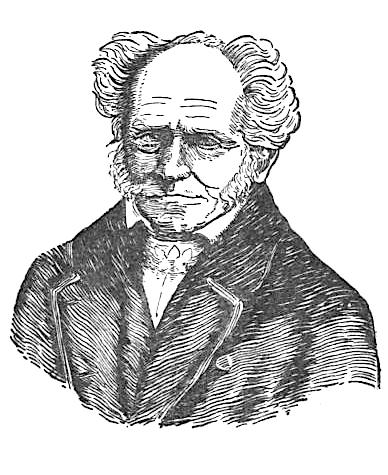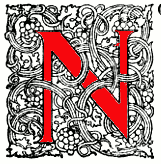"Life is assured to the will to live; the form of life is an endless present, no matter how the individuals, the phenomena of the Idea, arise and pass away in time, like fleeting dreams." — Schopenhauer, p. 362
Introduction
The following excerpts come from the Project Gutenberg version of The World As Will And Idea (Vol. 1 of 3: "Fourth Book: The World as Will"), based on the original work of 1818, which was extended later, and which made its full impact in Britain through R. B. Haldane and J. Kemp's translation of the 1880s. See the bibliography for full details. More paragraphing has been added for ease of reading.
The selection provides just a very brief taster of Arthur Schopenhauer's ideas. His view of life was bleak indeed, and by the end of the Victorian period the influence of his outlook was widespread. "In general," writes Ralph Goodale, looking at the translation history of his work, "an English author could hardly have known of Schopenhauer’s teachings before 1853; he would probably not have heard of the philosopher before 1872 nor have thought seriously of him until 1876, unless he had a special interest in Germany. By 1879, however, every person alive to the developments of the day must have heard of him; and by 1883 an educated man could not think of pessimism without thinking also of Schopenhauer" (242).
But there are two caveats here. One is that there were other sources of the pessimism at this time, not least the post-Darwinian falling away of religious faith. The other is that there were some important positives to take away from the German philosopher's work as well. Notable among Schopenhauer's ideas here are, indeed, his emphasis on life as suffering; but also his proposition that "[a]ll love ... is sympathy"; his respect for the "wisest of all mythologies, the Indian" (so entirely different from the colonial attitudes to Indian religions); and, contrary to facile assumptions, his objection to suicide. — Jacqueline Banerjee
Will

Arthur Schopenhauer. Source: Beer, frontispiece.

ill is the thing-in-itself, the inner content, the essence of the world. Life, the visible world, the phenomenon, is only the mirror of the will. Therefore life accompanies the will as inseparably as the shadow accompanies the body; and if will exists, so will life, the world, exist. Life is, therefore, assured to the will to live; and so long as we are filled with the will to live we need have no fear for our existence, even in the presence of death. It is true we see the individual come into being and pass away; but the individual is only phenomenal, exists only for the knowledge which is bound to the principle of sufficient reason, to the principio individuationis. Certainly, for this kind of knowledge, the individual receives his life as a gift, rises out of nothing, then suffers the loss of this gift through death, and returns again to nothing.
But we desire to consider life philosophically, i.e., according to its Ideas, and in this sphere we shall find that neither the will, the thing-in-itself in all phenomena, nor the subject of knowing, that which perceives all phenomena, is affected at all by birth or by death. Birth and death belong merely to the phenomenon of will, thus to life; and it is essential to this to exhibit itself in individuals which come into being and pass away, as fleeting phenomena appearing in the form of time—phenomena of that which in itself knows no time, but must exhibit itself precisely in the way we have said, in order to objectify its peculiar nature. Birth and death belong in like manner to life, and hold the balance as reciprocal conditions of each other, or, if one likes the expression, as poles of the whole phenomenon of life.
The wisest of all mythologies, the Indian, expresses this by giving to the very god that symbolises destruction, death (as Brahma, the most sinful and the lowest god of the Trimurti, symbolises generation, coming into being, and Vishnu maintaining or preserving), by giving, I say, to Siva as an attribute not only the necklace of skulls, but also the lingam, the symbol of generation, which appears here as the counterpart of death, thus signifying that generation and death are essentially correlatives, which reciprocally neutralise and annul each other. It was precisely the same sentiment that led the Greeks and Romans to adorn their costly sarcophagi, just as we see them now, with feasts, dances, marriages, the chase, fights of wild beasts, bacchanalians, &c.; thus with representations of the full ardour of life, which they place before us not only in such revels and sports, but also in sensual groups, and even go so far as to represent the sexual intercourse of satyrs and goats. Clearly the aim was to point in the most impressive manner away from the death of the mourned individual to the immortal life of nature, and thus to indicate, though without abstract knowledge, that the whole of nature is the phenomenon and also the fulfilment of the will to live.
Time

he form of this phenomenon is time, space, and causality, and by means of these individuation, which carries with it that the individual must come into being and pass away. But this no more affects the will to live, of whose manifestation the individual is, as it were, only a particular example or specimen, than the death of an individual injures the whole of nature. For it is not the individual, but only the species that Nature cares for, and for the preservation of which she so earnestly strives, providing for it with the utmost prodigality through the vast surplus of the seed and the great strength of the fructifying impulse. The individual, on the contrary, neither has nor can have any value for Nature, for her kingdom is infinite time and infinite space, and in these infinite multiplicity of possible individuals. Therefore she is always ready to let the individual fall, and hence it is not only exposed to destruction in a thousand ways by the most insignificant accident, but originally destined for it, and conducted towards it by Nature herself from the moment it has served its end of maintaining the species. Thus Nature naïvely expresses the great truth that only the Ideas, not the individuals, have, properly speaking, reality, i.e., are complete objectivity of the will.
Life and Death

ow, since man is Nature itself, and indeed Nature at the highest grade of its self-consciousness, but Nature is only the objectified will to live, the man who has comprehended and retained this point of view may well console himself, when contemplating his own death and that of his friends, by turning his eyes to the immortal life of Nature, which he himself is. This is the significance of Siva with the lingam, and of those ancient sarcophagi with their pictures of glowing life, which say to the mourning beholder, Natura non contristatur.
That generation and death are to be regarded as something belonging to life, and essential to this phenomenon of the will, arises also from the fact that they both exhibit themselves merely as higher powers of the expression [pg 357] of that in which all the rest of life consists. This is through and through nothing else than the constant change of matter in the fixed permanence of form; and this is what constitutes the transitoriness of the individual and the permanence of the species. Constant nourishment and renewal differ from generation only in degree, and constant excretion differs only in degree from death. The first shows itself most simply and distinctly in the plant. The plant is throughout a constant recurrence of the same impulse of its simplest fibre, which groups itself into leaf and branch. It is a systematic aggregate of similar plants supporting each other, whose constant reproduction is its single impulse. It ascends to the full satisfaction of this tendency through the grades of its metamorphosis, finally to the blossom and fruit, that compendium of its existence and effort in which it now attains, by a short way, to that which is its single aim, and at a stroke produces a thousand-fold what, up till then, it effected only in the particular case — the repetition of itself. Its earlier growth and development stands in the same relation to its fruit as writing stands to printing.
With the animal it is clearly quite the same. The process of nourishing is a constant reproduction; the process of reproduction is a higher power of nourishing. The pleasure which accompanies the act of procreation is a higher power of the agreeableness of the sense of life. On the other hand, excretion, the constant exhalation and throwing off of matter, is the same as that which, at a higher power, death, is the contrary of generation. And if here we are always content to retain the form without lamenting the discarded matter, we ought to bear ourselves in the same way if in death the same thing happens, in a higher degree and to the whole, as takes place daily and hourly in a partial manner in excretion: if we are indifferent to the one, we ought not to shrink from the other.
Therefore, from this point of view, it appears just as perverse to desire the continuance of an individuality which will be replaced by other individuals as to desire the permanence of matter which will be replaced by other matter. It appears just as foolish to embalm the body as it would be carefully to preserve its excrement. As to the individual consciousness which is bound to the individual body, it is absolutely interrupted every day by sleep. Deep sleep is, while it lasts, in no way different from death, into which, in fact, it often passes continuously, as in the case of freezing to death. It differs only with regard to the future, the awaking. Death is a sleep in which individuality is forgotten; everything else wakes again, or rather never slept.
The Present

bove all things, we must distinctly recognise that the form of the phenomenon of will, the form of life or reality, is really only the present, not the future nor the past. The latter are only in the conception, exist only in the connection of knowledge, so far as it follows the principle of sufficient reason. No man has ever lived in the past, and none will live in the future; the present alone is the form of all life, and is its sure possession which can never be taken from it. The present always exists, together with its content. Both remain fixed without wavering, like the rainbow on the waterfall. For life is firm and certain in the will, and the present is firm and certain in life. Certainly, if we reflect on the thousands of years that are past, of the millions of men who lived in them, we ask, What were they? what has become of them? But, on the other hand, we need only recall our own past life and renew its scenes vividly in our imagination, and then ask again, What was all this? what has become of it? As it is with it, so is it with the life of those millions.

The young Frederic Leighton's drawing of Schopenhauer in 1847.
[Click on the image to enlarge it and for more information.]
Or should we suppose that the past could receive a new existence because it has been sealed by death? Our own past, the most recent part of it, and even yesterday, is now no more than an empty dream of the fancy, and such is the past of all those millions. What was? What is? The will, of which life is the mirror, and knowledge free from will, which beholds it clearly in that mirror. Whoever has not yet recognised this, or will not recognise it, must add to the question asked above as to the fate of past generations of men this question also: Why he, the questioner, is so fortunate as to be conscious of this costly, fleeting, and only real present, while those hundreds of generations of men, even the heroes and philosophers of those ages, have sunk into the night of the past, and have thus become nothing; but he, his insignificant ego, actually exists? or more shortly, though somewhat strangely: Why this now, his now, is just now and was not long ago? Since he asks such strange questions, he regards his existence and his time as independent of each other, and the former as projected into the latter. He assumes indeed two nows — one which belongs to the object, the other which belongs to the subject, and marvels at the happy accident of their coincidence. But in truth, only the point of contact of the object, the form of which is time, with the subject, which has no mode of the principle of sufficient reason as its form, constitutes the present....
Suicide

herefore, if a man fears death as his annihilation, it is just as if he were to think that the sun cries out at evening, “Woe is me! for I go down into eternal night.” And conversely, whoever is oppressed with the burden of life, whoever desires life and affirms it, but abhors its torments, and especially can no longer endure the hard lot that has fallen to himself, such a man has no deliverance to hope for from death, and cannot right himself by suicide. The cool shades of Orcus allure him only with the false appearance of a haven of rest. The earth rolls from day into night, the individual dies, but the sun itself shines without intermission, an eternal noon. Life is assured to the will to live; the form of life is an endless present, no matter how the individuals, the phenomena of the Idea, arise and pass away in time, like fleeting dreams. Thus even already suicide appears to us as a vain and therefore a foolish action....
Links to related material
- Schopenhauer on "the æsthetical mode of contemplation" (excerpt from "The World as Idea")
- Thomas Hardy's Affinities With Arthur Schopenhauer and Eduard von Hartmann
- A Significant Proposal: A Glimmer of Light in George Gissing's Workers in the Dawn
- Nineteenth-Century views of religion in India
- Victorian Suicides: Mad Crimes and Sad Histories (A Victorian Web book, by Barbara T. Gates)
Bibliography
Beer, Margrieta. Schopenhauer. T.C. and E.C. Jack: London, [1914]. Internet Archive. Contributed by University of California Libraries. Web. 11 May 2022.
Goodale, Ralph. "Schopenhauer and Pessimism in Nineteenth Century English Literature." PMLA. Vol. 47, no. 1 (March 1932): 241–61.
Schopenhauer, Arthur. The World As Will And Idea (Vol. 1 of 3: "Fourth Book: The World as Will." Trans. R.B. Haldane and J. Kemp. 7th ed. 1909. London: Kegan Paul, Trench, Trübner & Co., 1909. Project Gutenberg. 354-362.
Created 11 May 2022